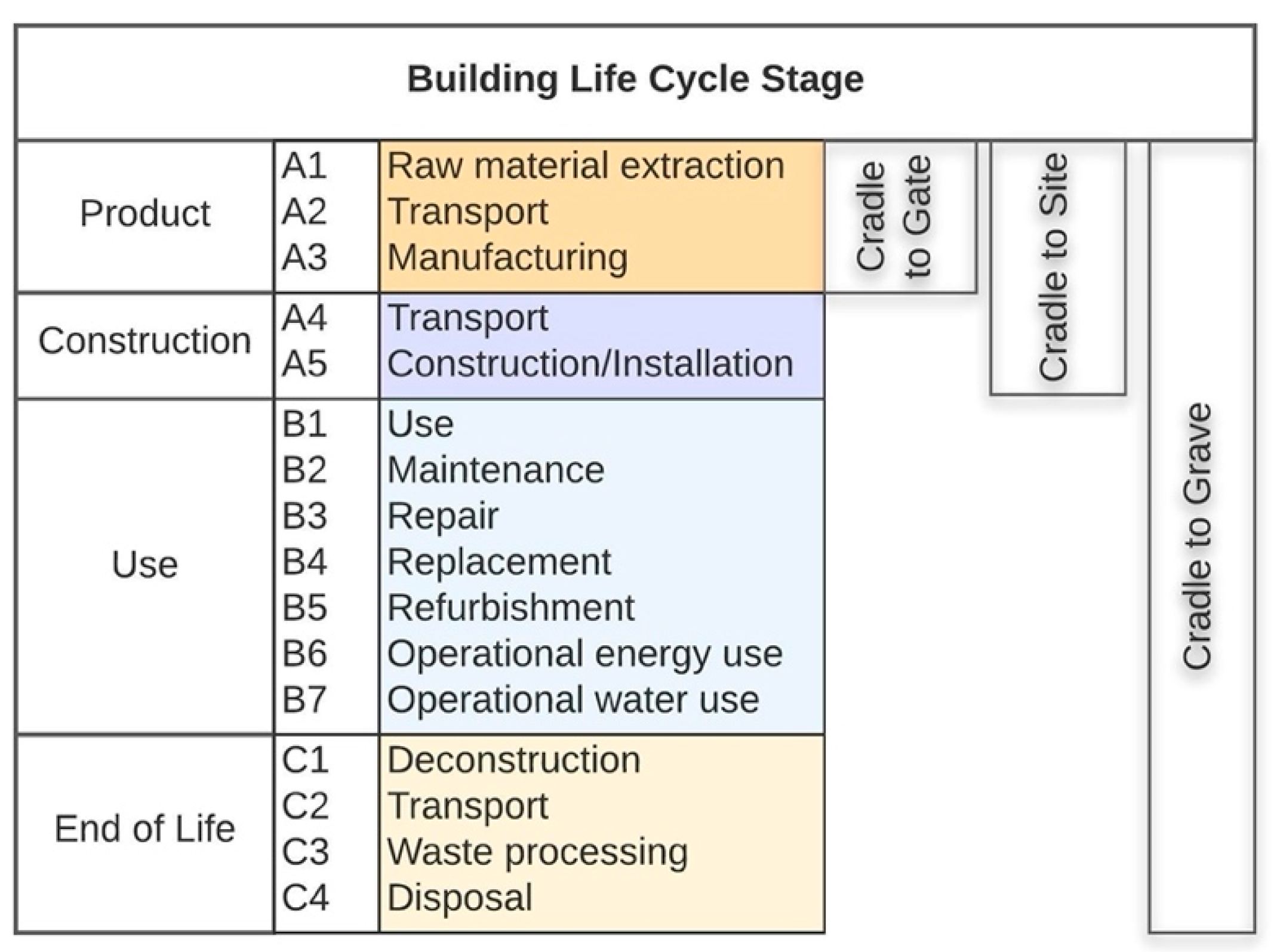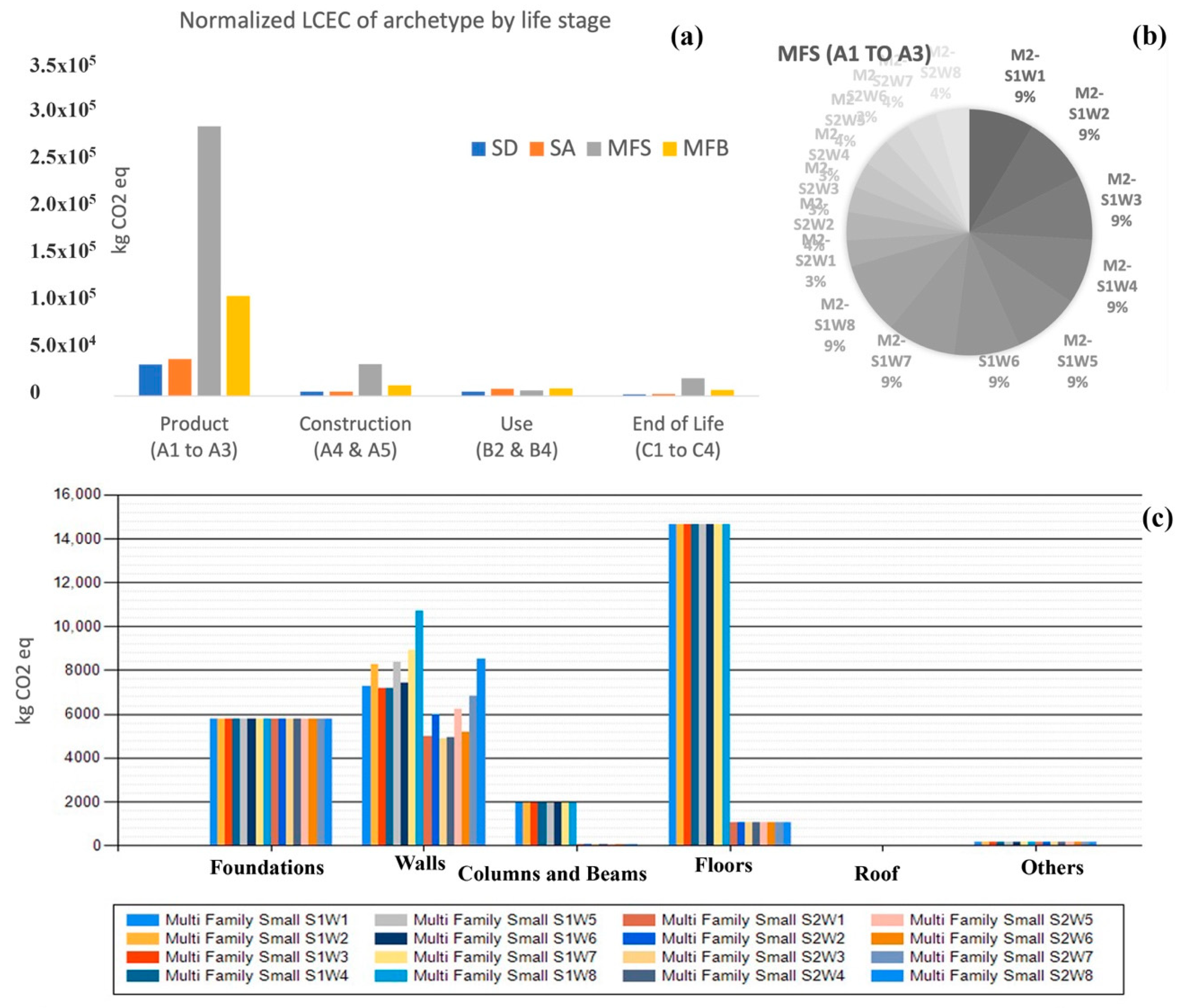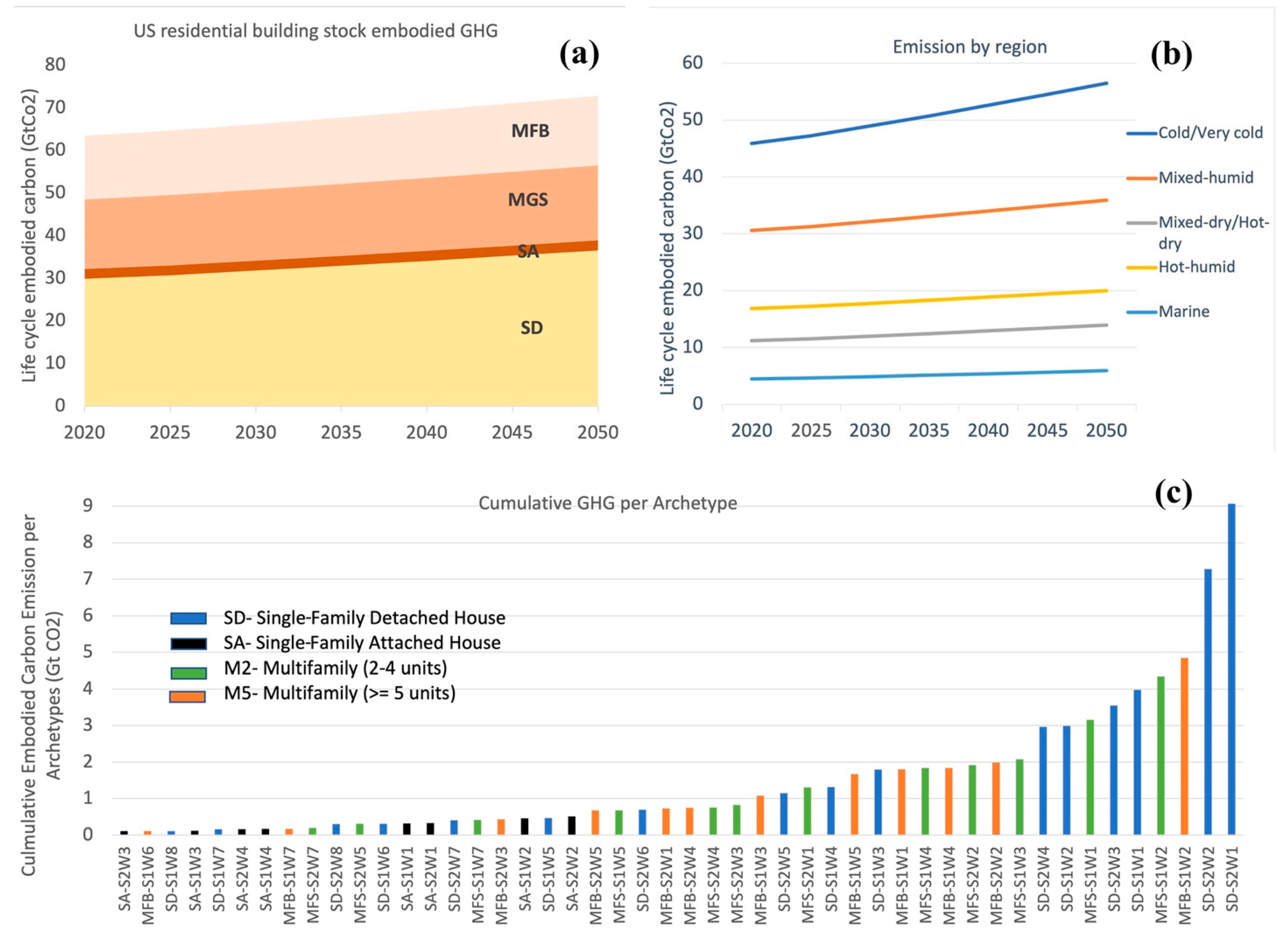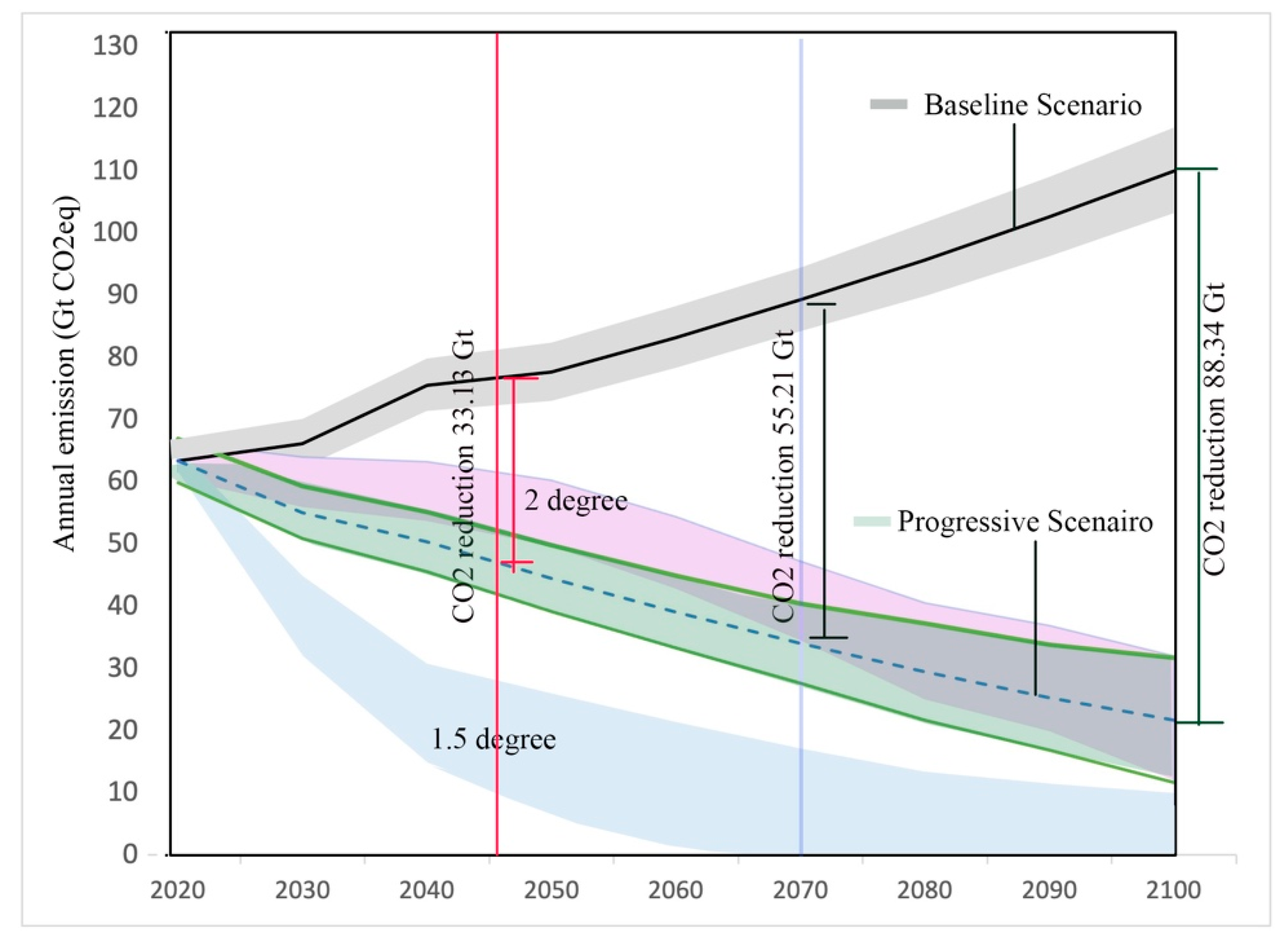Embodied Carbon Emissions of the Residential Building Stock in the United States and the Effectiveness of Mitigation Strategies
Abstract
:1. Introduction
2. Research Needs
3. Materials and Methodology
3.1. Definition and System Boundary of Embodied Carbon Study
3.2. Data and Process
3.2.1. Step One: Segment the Building Stock
3.2.2. Step Two: Develop the Archetypes
3.2.3. Step Three: Assess the Embodied Carbon of the Building Segment
3.3. Scenario Development
3.4. Estimation of the Mitigation Rate Consistent with Temperature Rise Prediction
4. Results and Findings
4.1. Existing Building Stock Descriptive Statistics
4.2. Embodied Carbon from the Existing Residential Building Stock
4.3. Baseline Emissions
4.4. Carbon Emission Mitigation Strategies
4.5. Progressive Scenario
5. Discussion
6. Conclusions
Funding
Institutional Review Board Statement
Informed Consent Statement
Data Availability Statement
Conflicts of Interest
Nomenclature
| RECS | Residential Energy Consumption Survey |
| SD | Single-family detached |
| SA | Single-family attached |
| MFS | Multifamily 2–4 units |
| MFB | Multifamily ≥ 5 units |
| AHS | American Housing Survey |
| LCEC | Life cycle embodied carbon |
References
- U.S. Department of Housing and Urban Development. National Comprehensive Housing Market Analysis. Available online: https://www.huduser.gov/PORTAL/ushmc/chma_archive.html (accessed on 20 June 2022).
- The National Association of Home Builders. Housing Economics Forecasts. Available online: https://www.nahb.org/news-and-economics/housing-economics/forecasts (accessed on 20 June 2022).
- United National Environment Programme. 2021 Global status report for buildings and construction. Available online: https://globalabc.org/sites/default/files/2021-10/2021%20Buildings-GSR%20-%20Executive%20Summary%20ENG.pdf (accessed on 20 June 2022).
- Mata, É.; Kalagasidis, A.S.; Johnsson, F. Building-stock aggregation through archetype buildings: France, Germany, Spain and the UK. Build. Environ. 2014, 81, 270–282. [Google Scholar] [CrossRef]
- Streicher, K.N.; Padey, P.; Parra, D.; Bürer, M.C.; Patel, M.K. Assessment of the current thermal performance level of the Swiss residential building stock: Statistical analysis of energy performance certificates. Energy Build. 2018, 178, 360–378. [Google Scholar] [CrossRef]
- Alves, T.; Machado, L.; de Souza, R.G.; de Wilde, P. Assessing the energy saving potential of an existing high-rise office building stock. Energy Build. 2018, 173, 547–561. [Google Scholar] [CrossRef]
- Röck, M.; Saade, M.R.M.; Balouktsi, M.; Rasmussen, F.N.; Birgisdottir, H.; Frischknecht, R.; Habert, G.; Lützkendorf, T.; Passer, A. Embodied GHG emissions of buildings–The hidden challenge for effective climate change mitigation. Appl. Energy 2020, 258, 114107. [Google Scholar] [CrossRef]
- Hu, M.; Esram, N.W. The Status of Embodied Carbon in Building Practice and Research in the United States: A Systematic Investigation. Sustainabilty 2021, 13, 12961. [Google Scholar] [CrossRef]
- US Energy Information Administration. Residential Energy Consumption Survey (RECS). May 2018. Available online: https://www.eia.gov/consumption/residential/data/2015/hc/php/hc10.1.php (accessed on 31 March 2021).
- US Energy Information Administration. Commercial Buildings Energy Consumption Survey (CBECS). May 2016. Available online: https://www.eia.gov/consumption/commercial/data/2012/bc/cfm/b34.php (accessed on 12 June 2022).
- Lee, B.; Trcka, M.; Hensen, J.L. Embodied energy of building materials and green building rating systems—A case study for industrial halls. Sustain. Cities Soc. 2011, 1, 67–71. [Google Scholar] [CrossRef]
- Omar, W.M.; Doh, J.H.; Panuwatwanich, K.; Miller, D. Assessment of the embodied carbon in precast concrete wall panels using a hybrid life cycle assessment approach in Malaysia. Sustain. Cities Soc. 2014, 10, 101–111. [Google Scholar] [CrossRef]
- Sharma, A.; Shree, V.; Nautiyal, H. Life cycle environmental assessment of an educational building in Northern India: A case study. Sustain. Cities Soc. 2012, 4, 22–28. [Google Scholar]
- Junnila, S.; Horvath, A.; Guggemos, A.A. Life-cycle assessment of office buildings in Europe and the United States. J. Infrastruct. Syst. 2006, 12, 10–17. [Google Scholar] [CrossRef]
- Kofoworola, O.F.; Gheewala, S.H. Environmental life cycle assessment of a commercial office building in Thailand. Int. J. Life Cycle Assess. 2008, 13, 498–511. [Google Scholar] [CrossRef]
- Blengini, G.A. Life cycle of buildings, demolition and recycling potential: A case study in Turin, Italy. Build. Environ. 2009, 44, 319–330. [Google Scholar] [CrossRef]
- Chastas, P.; Theodosiou, T.; Kontoleon, K.J.; Bikas, D. Normalising and assessing carbon emissions in the building sector: A review on the embodied CO2 emissions of residential buildings. Build. Environ. 2018, 130, 212–226. [Google Scholar] [CrossRef]
- Islam, H.; Jollands, M.; Setunge, S. Life cycle assessment and life cycle cost implication of residential buildings—A review. Renew. Sustain. Energy Rev. 2015, 42, 129–140. [Google Scholar] [CrossRef]
- Plank, B.; Streeck, J.; Virág, D.; Krausmann, F.; Haberl, H.; Wiedenhofer, D. From resource extraction to manufacturing and construction: Flows of stock-building materials in 177 countries from 1900 to 2016. Resour. Conserv. Recycl. 2022, 179, 106122. [Google Scholar] [CrossRef]
- Liang, S.; Gu, H.; Bergman, R.; Kelley, S.S. Comparative life-cycle assessment of a mass timber building and concrete alternative. Wood Fiber Sci. 2020, 52, 217–229. [Google Scholar] [CrossRef]
- Blanchard, S.; Reppe, P. Life Cycle Analysis of a Residential Home in Michigan; Technical Report No. CSS98-05; Center for Sustainable Systems-University of Michigan: Ann Arbor, MI, USA, 1998. [Google Scholar]
- Keoleian, G.A.; Blanchard, S.; Reppe, P. Life-cycle energy, costs, and strategies for improving a single-family house. J. Ind. Ecol. 2000, 4, 135–156. [Google Scholar] [CrossRef]
- Marceau, M.L.; Gajda, J.; VanGeem, M.G.; Gentry, T.; Nisbet, M.A. Partial environmental life cycle inventory of a concrete masonry house compared to a wood frame house. RD Ser. 2002, 2465–2466. [Google Scholar]
- Scheuer, C.; Keoleian, G.A.; Reppe, P. Life cycle energy and environmental performance of a new university building: Modeling challenges and design implications. Energy Build. 2003, 35, 1049–1064. [Google Scholar] [CrossRef]
- Kahhat, R.; Crittenden, J.; Sharif, F.; Fonseca, E.; Li, K.; Sawhney, A.; Zhang, P. Environmental impacts over the life cycle of residential buildings using different exterior wall systems. J. Infrastruct. Syst. 2009, 15, 211–221. [Google Scholar] [CrossRef]
- Bilec, M.M.; Ries, R.J.; Matthews, H.S. Life-cycle assessment modeling of construction processes for buildings. J. Infrastruct. Syst. 2010, 16, 199–205. [Google Scholar] [CrossRef]
- Thiel, C.L.; Campion, N.; Landis, A.E.; Jones, A.K.; Schaefer, L.A.; Bilec, M.M. A materials life cycle assessment of a net-zero energy building. Energies 2013, 6, 1125–1141. [Google Scholar] [CrossRef]
- Mosteiro-Romero, M.; Krogmann, U.; Wallbaum, H.; Ostermeyer, Y.; Senick, J.S.; Andrews, C.J. Relative importance of electricity sources and construction practices in residential buildings: A Swiss-US comparison of energy related life-cycle impacts. Energy Build. 2014, 68, 620–631. [Google Scholar] [CrossRef]
- Meneghelli, A. Whole-building embodied carbon of a North American LEED-certified library: Sensitivity analysis of the environmental impact of buildings materials. Build. Environ. 2018, 134, 230–241. [Google Scholar] [CrossRef]
- Rodriguez, B.X.; Huang, M.; Lee, H.W.; Simonen, K.; Ditto, J. Mechanical, electrical, plumbing and tenant improvements over the building lifetime: Estimating material quantities and embodied carbon for climate change mitigation. Energy Build. 2020, 226, 110324. [Google Scholar] [CrossRef]
- Reyna, J.; Wilson, E.; Satre-Meloy, A.; Egerter, A.; Bianchi, C.; Praprost, M.; Speake, A.; Liu, L.; Parker, A.; Horsey, R.; et al. US Building Stock Characterization Study: A National Typology for Decarbonizing US Buildings. Part. 1: Residential Buildings; Technical Report No. NREL/TP-5500-81186; National Renewable Energy Lab. (NREL): Golden, CO, USA, 2021.
- Kavgic, M.; Mavrogianni, A.; Mumovic, D.; Summerfield, A.; Stevanovic, Z.; Djurovic-Petrovic, M. A review of bottom-up building stock models for energy consumption in the residential sector. Build. Environ. 2010, 45, 1683–1697. [Google Scholar] [CrossRef]
- Tuominen, P.; Holopainen, R.; Eskola, L.; Jokisalo, J.; Airaksinen, M. Calculation method and tool for assessing energy consumption in the building stock. Build. Environ. 2014, 75, 153–160. [Google Scholar] [CrossRef]
- Wang, D.; Landolt, J.; Mavromatidis, G.; Orehounig, K.; Carmeliet, J. CESAR: A bottom-up building stock modelling tool for Switzerland to address sustainable energy transformation strategies. Energy Build. 2018, 169, 9–26. [Google Scholar] [CrossRef]
- Hu, M. A Building life-cycle embodied performance index—The relationship between embodied energy, embodied carbon and environmental impact. Energies 2020, 13, 1905. [Google Scholar] [CrossRef]
- Hu, M. Net Zero Energy Building: Predicted and Unintended Consequences; Routledge: Abingdon, UK, 2019. [Google Scholar]
- Kavitha, S.; Banu, J.R.; Arulazhagan, P.; Gunasekaran, M. Environmental impacts and sustainability assessment of food loss and waste valorization: Value chain analysis of food consumption. In Food Waste to Valuable Resources; Academic Press: Cambridge, MA, USA, 2020; pp. 359–388. [Google Scholar]
- Li, M.; Subramaniam, B. LCA for Green Chemical Synthesis—Terephthalic Acid. 2017, pp. 387–396. Available online: https://www.researchgate.net/publication/315854215_LCA_for_Green_Chemical_Synthesis-Terephthalic_Acid (accessed on 9 August 2022).
- Pomponi, F.; Moncaster, A. Embodied carbon mitigation and reduction in the built environment—What does the evidence say? J. Environ. Manag. 2016, 181, 687–700. [Google Scholar] [CrossRef]
- Ballarini, I.; Corgnati, S.P.; Corrado, V. Use of reference buildings to assess the energy saving potentials of the residential building stock: The experience of TABULA project. Energy Policy 2014, 68, 273–284. [Google Scholar] [CrossRef]
- United States Census Bureau. American Housing Survey. Available online: https://www.census.gov/programs-surveys/ahs.htmlv (accessed on 9 February 2022).
- U.S. Energy Information Administrative. Residential Energy Consumption Survey (2015). Available online: https://www.eia.gov/consumption/residential/about.php (accessed on 10 February 2022).
- Department of Energy. Building Science-Based Climate Maps. Available online: https://www.energy.gov/sites/default/files/2014/01/f6/4_3a_ba_innov_buildingscienceclimatemaps_011713.pdf (accessed on 30 January 2022).
- Langevin, J.; Reyna, J.L.; Ebrahimigharehbaghi, S.; Sandberg, N.; Fennell, P.; Nägeli, C.; Laverge, J.; Delghust, M.; Mata, É.; Van Hove, M.; et al. Developing a common approach for classifying building stock energy models. Renew. Sustain. Energy Rev. 2020, 133, 110276. [Google Scholar] [CrossRef]
- Shimoda, Y.; Sugiyama, M.; Nishimoto, R.; Momonoki, T. Evaluating decarbonization scenarios and energy management requirement for the residential sector in Japan through bottom-up simulations of energy end-use demand in 2050. Appl. Energy 2021, 303, 117510. [Google Scholar] [CrossRef]
- De Wolf, C.; Pomponi, F.; Moncaster, A. Measuring embodied carbon dioxide equivalent of buildings: A review and critique of current industry practice. Energy Build. 2017, 140, 68–80. [Google Scholar] [CrossRef]
- Vigon, B.W.; Vigon, B.W.; Harrison, C.L. Life-Cycle Assessment: Inventory Guidelines and Principles; US Environmental Protection Agency: Cincinnati, OH, USA, 1993.
- Hu, M.; Cunningham, P.; Gilloran, S. Sustainable design rating system comparison using a life-cycle methodology. Build. Environ. 2017, 126, 410–421. [Google Scholar] [CrossRef]
- Zhong, X.; Hu, M.; Deetman, S.; Steubing, B.; Lin, H.X.; Hernandez, G.A.; Harpprecht, C.; Zhang, C.; Tukker, A.; Behrens, P. Global greenhouse gas emissions from residential and commercial building materials and mitigation strategies to 2060. Nat. Commun. 2021, 12, 1–10. [Google Scholar] [CrossRef] [PubMed]
- Rogelj, J.; Shindell, D.; Jiang, K.; Fifita, S.; Forster, P.; Ginzburg, V.; Handa, C.; Kheshgi, H.; Kobayashi, S.; Kriegler, E.; et al. 2018: Mitigation Pathways Compatible with 1.5 °C in the Context of Sustainable Development. In Global Warming of 1.5 °C. An IPCC Special Report on the Impacts of Global Warming of 1.5 °C above Pre-Industrial Levels and Related Global Greenhouse Gas Emission Pathways, in the Context of Strengthening the Global Response to the Threat of Climate Change, Sustainable Development, and Efforts to Eradicate Poverty; Masson-Delmotte, V., P. Zhai, H.-O., Pörtner, D., Roberts, J., Skea, P.R., Shukla, A., Pirani, W., Moufouma-Okia, C., Péan, R., Pidcock, S., et al., Eds.; Available online: https://pure.iiasa.ac.at/id/eprint/15716/1/SR15_TS_High_Res.pdf (accessed on 9 February 2022).
- United States Census Bureau. 2020 Population and Housing State Data. Available online: https://www.census.gov/library/visualizations/interactive/2020-population-and-housing-state-data.html (accessed on 9 February 2022).
- United States Census Bureau. Growth in Housing Units Slowed in the Last Decade. Available online: https://www.census.gov/library/stories/2021/08/growth-in-housing-units-slowed-in-last-decade.html (accessed on 9 February 2022).
- Moura, M.C.P.; Smith, S.J.; Belzer, D.B. 120 years of US residential housing stock and floor space. PLoS ONE 2015, 10, e0134135. [Google Scholar]
- Rogelj, J.; Shindell, D.; Jiang, K.; Fifita, S.; Forster, P.; Ginzburg, V.; Handa, C.; Kheshgi, H.; Kobayashi, S.; Kriegler, E.; et al. Mitigation pathways compatible with 1.5 C in the context of sustainable development. In Global Warming of 1.5 °C; Intergovernmental Panel on Climate Change: Geneva, Switzerland, 2018; pp. 93–174. [Google Scholar]
- Hertwich, E.; Lifset, R.; Pauliuk, S.; Heeren, N.; Ali, S.; Tu, Q.; Ardente, F.; Berrill, P.; Fishman, T.; Kanaoka, K.; et al. Resource Efficiency and Climate Change: Material Efficiency Strategies for a Low-Carbon Future; United Nations International Resource Panel (IRP): Nairobi, Kenya, 2020. [Google Scholar]
- Milford, R.L.; Pauliuk, S.; Allwood, J.M.; Muüller, D.B. The roles of energy and material efficiency in meeting steel industry CO2 targets. Environ. Sci. Technol. 2013, 47, 3455–3462. [Google Scholar] [CrossRef]
- Hao, J.L.; Cheng, B.; Lu, W.; Xu, J.; Wang, J.; Bu, W.; Guo, Z. Carbon emission reduction in prefabrication construction during materialization stage: A BIM-based life-cycle assessment approach. Sci. Total Environ. 2020, 723, 137870. [Google Scholar] [CrossRef]
- Collins, M.; Knutti, R.; Arblaster, J.; Dufresne, J.L.; Fichefet, T.; Friedlingstein, P.; Gao, X.; Gutowski, W.J.; Johns, T.; Krinner, G.; et al. Long-term climate change: Projections, commitments and irreversibility. In Climate Change 2013—The Physical Science Basis: Contribution of Working Group I to the Fifth Assessment Report of the Intergovernmental Panel on Climate Change; Cambridge University Press: Cambridge, UK, 2013; pp. 1029–1136. [Google Scholar]
- Union of Concerned Scientists. Each Country’s Share of CO2 Emission. Available online: https://www.ucsusa.org/resources/each-countrys-share-co2-emissions (accessed on 9 February 2022).
- United Nations Environment Programme. 2021 Global Status Report for Buildings and Construction: Towards a Zero-Emission, Efficient and Resilient Buildings and Construction Sector. Nairobi. 2021. Available online: https://www.unep.org/resources/report/2021-global-status-report-buildings-and-construction (accessed on 9 February 2022).
- Construction Physics. Every Building in America-an Analysis of the US Building Stock. Available online: https://constructionphysics.substack.com/p/every-building-in-america-an-analysis (accessed on 1 February 2022).
- Raupach, M.R.; Davis, S.J.; Peters, G.P.; Andrew, R.M.; Canadell, J.G.; Ciais, P.; Friedlingstein, P.; Jotzo, F.; Van Vuuren, D.P.; Le Quéré, C. Sharing a quota on cumulative carbon emissions. Nat. Clim. Chang. 2014, 4, 873–879. [Google Scholar] [CrossRef]
- Yu, D.; Tan, H.; Ruan, Y. A future bamboo-structure residential building prototype in China: Life cycle assessment of energy use and carbon emission. Energy Build. 2011, 43, 2638–2646. [Google Scholar] [CrossRef]
- Nadoushani, Z.S.M.; Akbarnezhad, A. Effects of structural system on the life cycle carbon footprint of buildings. Energy Build. 2015, 102, 337–346. [Google Scholar] [CrossRef]
- Wang, P.; Ryberg, M.; Yang, Y.; Feng, K.; Kara, S.; Hauschild, M.; Chen, W.Q. Efficiency stagnation in global steel production urges joint supply-and demand-side mitigation efforts. Nat. Commun. 2021, 12, 1–11. [Google Scholar] [CrossRef] [PubMed]
- Churkina, G.; Organschi, A.; Reyer, C.P.; Ruff, A.; Vinke, K.; Liu, Z.; Reck, B.K.; Graedel, T.E.; Schellnhuber, H.J. Buildings as a global carbon sink. Nat. Sustain. 2020, 3, 269–276. [Google Scholar] [CrossRef]
- Structure Magazine. Groundbreaking: Tall Mass Timber Construction Types Included in 2021 IBC. Available online: https://www.structuremag.org/?p=14545 (accessed on 31 January 2022).
- Wang, Q.; Wang, X. Moving to economic growth without water demand growth—A decomposition analysis of decoupling from economic growth and water use in 31 provinces of China. Sci. Total Environ. 2020, 726, 138362. [Google Scholar] [CrossRef]
- Dodoo, A.; Gustavsson, L.; Sathre, R. Carbon implications of end-of-life management of building materials. Resour. Conserv. Recycl. 2009, 53, 276–286. [Google Scholar] [CrossRef]
- Liu, G.; Bangs, C.E.; Müller, D.B. Stock dynamics and emission pathways of the global aluminium cycle. Nat. Clim. Chang. 2013, 3, 338–342. [Google Scholar] [CrossRef]
- Mao, C.; Shen, Q.; Shen, L.; Tang, L. Comparative study of greenhouse gas emissions between off-site prefabrication and conventional construction methods: Two case studies of residential projects. Energy Build. 2013, 66, 165–176. [Google Scholar] [CrossRef]
- Teng, Y.; Pan, W. Estimating and minimizing embodied carbon of prefabricated high-rise residential buildings considering parameter, scenario and model uncertainties. Build. Environ. 2020, 180, 106951. [Google Scholar] [CrossRef]
- Robati, M.; Oldfield, P.; Nezhad, A.A.; Carmichael, D.G.; Kuru, A. Carbon value engineering: A framework for integrating embodied carbon and cost reduction strategies in building design. Build. Environ. 2021, 192, 107620. [Google Scholar] [CrossRef]
- Andersen, J.H.; Rasmussen, N.L.; Ryberg, M.W. Comparative life cycle assessment of cross laminated timber building and concrete building with special focus on biogenic carbon. Energy Build. 2022, 254, 111604. [Google Scholar] [CrossRef]
- United States Census. Highlights of Annual 2020 Characteristics of New Housing. Available online: https://www.census.gov/construction/chars/highlights.html (accessed on 24 January 2022).







| Ref. # | Author | Year | State | EC Scope | EC Boundary | ECEI (kgCO2eq/m2/y) | Building Type | Construction | Area (m2) | Life Span | Method/Database Tool |
|---|---|---|---|---|---|---|---|---|---|---|---|
| [21] | Blanchard and Reppe | 1998 | MI | A-C | Whole building | 92 | SD | Wood | 220.5 | 50 | DEAM database (French) |
| [22] | Keoleian et al. | 2000 | MI | A-C | Whole building | 89 | SD | Wood stud | 228 | 50 | Excel sheet/ use mass and emissions factor of materials |
| [23] | Marceau et al. | 2002 | AZ, Fl, WA, IL, DC | A-D | STR only | 23.5–110 | SD | Wood vs. concrete | 203 | 100 | Unknown |
| [24] | Scheuer et al. | 2003 | MI | A-C | Whole building | 185 | ED | Concrete | 7300 | 100 | SimaPro |
| [14] | Junnila et al. | 2006 | IL | A-C | Whole building | 530 | Off | Concrete | Unknown | 50 | Carnegie Mellon tool |
| [25] | Kahhat et al. | 2009 | AZ | A-C | Exterior wall | SD | Compare wall system | 200 | 50 | Athena | |
| [26] | Bilec et al. | 2010 | PA | A-C | Whole building | 116 | Off | Steel | 17280 | 50 | Carnegie Mellon tool/EIO-LCA |
| [27] | Thiel et al. | 2013 | PA | A-C | 390 | Off | Concrete | 22672 | 50 | Unknown | |
| [28] | Mosteiro-Romero et al. | 2014 | NJ | A-C | Whole building | 42 | SD | Wood and concrete | 255 | 65 | IMPACT 2002+ Method/Ecoinvent 2.2 |
| [29] | Meneghel-li | 2018 | IL | A1-B5, excl. A5 | Whole building | 580 | Lib | Concrete and steel | 2410 | 60 | Excel sheet/University of Bath data |
| [30] | Rodriguez et al. | 2020 | WA | A1-A3 | MEP and interior | 40–75 (MEP) 45–135 (IN) | Off | NA | 185–745322 | 50 | EPD |
| Archetype | Single-Family Detached (SD) | Single-Family Attached (SA) | Multifamily 2–4 Units (MFS) | Multifamily ≥5 Units (MFB) | ||||
|---|---|---|---|---|---|---|---|---|
| Construction Type | S1 | S2 | S1 | S2 | S1 | S2 | S1 | S2 |
| Floor area (ft2) | 2150 | 2184 | 2555 | 2811 | 2815 | 2939 | 15,324 | 15,452 |
| Height/stories | 1 | 1 | 2 | 2 | 3 | 3 | 6 | 6 |
| Number of bedrooms | 3 | 3 | 2 | 2 | 2 | 2 | 2 | 2 |
| Number of windows | 12 | 12 | 8 | 8 | 8 | 8 | 4 | 4 |
| Total area of windows | 96 | 96 | 64 | 64 | 64 | 64 | 32 | 32 |
| Type of window | Double-pane glass w/wood frame | Double-pane glass w/metal frame | Single-pane glass w/metal frame | Single-pane glass w/metal frame | ||||
| Basement | Y | Y | Y | Y | N | N | N | N |
| Foundation | Concrete | |||||||
| Roofing | Shingles (composition or asphalt) | |||||||
| Construction type | S1 | S2 | S1 | S2 | S1 | S2 | S1 | S2 |
| Adequate insulation | Y | Y | Y | Y | Y | Y | Y | Y |
| Wall material | W1–W8 | W1–W6 | W1–W5, W7 | W1–W8 | ||||
| Climate Region | Housing Growth Rate (%) | Building Segment Makeup |
|---|---|---|
| Cold/Very Cold | 7.19 | SD (67%), SA (6%), MFS (11%), MFB (16%) |
| Mixed–Humid | 5.55 | SD (65%), SA (8%), MFS (7%), MFB (20%) |
| Hot–Humid | 7.64 | SD (56%), SA (8%), MFS (10%), MFB (26%) |
| Hot–Dry/Mixed–Dry | 5.97 | SD (70%), SA (5%), MFS (6%), MFB (20%) |
| Marine | 9.60 | SD (77%), SA (5%), MFS (5%), MFB (13%) |
| Mitigating Strategies | Description |
|---|---|
| M1—Efficient use of space | The floor area per person is reduced by 20%, thus reducing the built floor area [53] |
| M2—Extended life span | Up to a 90% lifetime extension by 2050 [12] |
| M3—Lightweight materials | Reduce heavyweight materials—steel (19%), metal (19%), and concrete (10%)—by 2050 [12,54] |
| M4—Use of wood products | 10% of building materials are replaced by wood products by 2050 [12] |
| M5—Recycle and reuse | Maximum recycling and reuse rates estimated by 2050 (90% steel, 90% metal, 15% concrete) [13,14] |
| M6— Prefabrication construction | Replaced in situ construction methods with prefabricated components (reduce whole-building carbon by 15%) [55] |
| Mitigation Reduction GT CO2eq | ||||||
|---|---|---|---|---|---|---|
| M1 | M2 | M3 | M4 | M5 | M6 | |
| SD | 12.95 | 1.20 | 3.83 | 9.57 | 6.38 | 1.66 |
| SA | 0.80 | 0.53 | 0.58 | 0.58 | 0.44 | 0.11 |
| MFS | 1.42 | 4.07 | 11.74 | 5.87 | 0.82 | 0.84 |
| MFB | 0 | 8.12 | 10.41 | 4.17 | 1.14 | 1.12 |
Publisher’s Note: MDPI stays neutral with regard to jurisdictional claims in published maps and institutional affiliations. |
© 2022 by the author. Licensee MDPI, Basel, Switzerland. This article is an open access article distributed under the terms and conditions of the Creative Commons Attribution (CC BY) license (https://creativecommons.org/licenses/by/4.0/).
Share and Cite
Hu, M. Embodied Carbon Emissions of the Residential Building Stock in the United States and the Effectiveness of Mitigation Strategies. Climate 2022, 10, 135. https://doi.org/10.3390/cli10100135
Hu M. Embodied Carbon Emissions of the Residential Building Stock in the United States and the Effectiveness of Mitigation Strategies. Climate. 2022; 10(10):135. https://doi.org/10.3390/cli10100135
Chicago/Turabian StyleHu, Ming. 2022. "Embodied Carbon Emissions of the Residential Building Stock in the United States and the Effectiveness of Mitigation Strategies" Climate 10, no. 10: 135. https://doi.org/10.3390/cli10100135
APA StyleHu, M. (2022). Embodied Carbon Emissions of the Residential Building Stock in the United States and the Effectiveness of Mitigation Strategies. Climate, 10(10), 135. https://doi.org/10.3390/cli10100135







